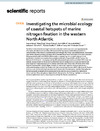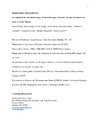Identificador persistente para citar o vincular este elemento:
https://accedacris.ulpgc.es/jspui/handle/10553/106006
| Campo DC | Valor | idioma |
|---|---|---|
| dc.contributor.author | Wang, Seaver | en_US |
| dc.contributor.author | Tang, Weiyi | en_US |
| dc.contributor.author | Delage, Erwan | en_US |
| dc.contributor.author | Gifford, Scott | en_US |
| dc.contributor.author | Whitby, Hannah | en_US |
| dc.contributor.author | González, Aridane G. | en_US |
| dc.contributor.author | Eveillard, Damien | en_US |
| dc.contributor.author | Planquette, Hélène | en_US |
| dc.contributor.author | Cassar, Nicolas | en_US |
| dc.date.accessioned | 2021-03-22T11:33:57Z | - |
| dc.date.available | 2021-03-22T11:33:57Z | - |
| dc.date.issued | 2021 | en_US |
| dc.identifier.issn | 2045-2322 | en_US |
| dc.identifier.other | Scopus | - |
| dc.identifier.uri | https://accedacris.ulpgc.es/handle/10553/106006 | - |
| dc.description.abstract | Variation in the microbial cycling of nutrients and carbon in the ocean is an emergent property of complex planktonic communities. While recent findings have considerably expanded our understanding of the diversity and distribution of nitrogen (N2) fixing marine diazotrophs, knowledge gaps remain regarding ecological interactions between diazotrophs and other community members. Using quantitative 16S and 18S V4 rDNA amplicon sequencing, we surveyed eukaryotic and prokaryotic microbial communities from samples collected in August 2016 and 2017 across the Western North Atlantic. Leveraging and significantly expanding an earlier published 2015 molecular dataset, we examined microbial community structure and ecological co-occurrence relationships associated with intense hotspots of N2 fixation previously reported at sites off the Southern New England Shelf and Mid-Atlantic Bight. Overall, we observed a negative relationship between eukaryotic diversity and both N2 fixation and net community production (NCP). Maximum N2 fixation rates occurred at sites with high abundances of mixotrophic stramenopiles, notably Chrysophyceae. Network analysis revealed such stramenopiles to be keystone taxa alongside the haptophyte diazotroph host Braarudosphaera bigelowii and chlorophytes. Our findings highlight an intriguing relationship between marine stramenopiles and high N2 fixation coastal sites. | en_US |
| dc.language | eng | en_US |
| dc.relation | NSF-CAREER grant awarded to NC (#1350710) a Chateaubriand Fellowship awarded to SW | en_US |
| dc.relation | ANR grant awarded to HP (ANR-12-PDOC-0025-01) | en_US |
| dc.relation | ProBioSTIC-AtlanSTIC2020 | en_US |
| dc.relation.ispartof | Scientific Reports | en_US |
| dc.source | Scientific Reports [EISSN 2045-2322], v. 11(1), 5508 | en_US |
| dc.subject | 251002 Oceanografía química | en_US |
| dc.title | Investigating the microbial ecology of coastal hotspots of marine nitrogen fixation in the western North Atlantic | en_US |
| dc.type | info:eu-repo/semantics/Article | en_US |
| dc.type | Article | en_US |
| dc.identifier.doi | 10.1038/s41598-021-84969-1 | en_US |
| dc.identifier.scopus | 85102285216 | - |
| dc.contributor.authorscopusid | 57202609247 | - |
| dc.contributor.authorscopusid | 57200721082 | - |
| dc.contributor.authorscopusid | 57201642912 | - |
| dc.contributor.authorscopusid | 23018622900 | - |
| dc.contributor.authorscopusid | 56401787600 | - |
| dc.contributor.authorscopusid | 37031064100 | - |
| dc.contributor.authorscopusid | 55886516700 | - |
| dc.contributor.authorscopusid | 22836555200 | - |
| dc.contributor.authorscopusid | 6603417649 | - |
| dc.identifier.eissn | 2045-2322 | - |
| dc.identifier.issue | 1 | - |
| dc.relation.volume | 11 | en_US |
| dc.investigacion | Ciencias | en_US |
| dc.type2 | Artículo | en_US |
| dc.description.numberofpages | 14 | en_US |
| dc.utils.revision | Sí | en_US |
| dc.identifier.ulpgc | Sí | en_US |
| dc.contributor.buulpgc | BU-BAS | en_US |
| dc.description.sjr | 1,005 | |
| dc.description.jcr | 4,996 | |
| dc.description.sjrq | Q1 | |
| dc.description.jcrq | Q2 | |
| dc.description.scie | SCIE | |
| dc.description.miaricds | 10,5 | |
| item.fulltext | Con texto completo | - |
| item.grantfulltext | open | - |
| crisitem.author.dept | GIR IOCAG: Química Marina | - |
| crisitem.author.dept | IU de Oceanografía y Cambio Global | - |
| crisitem.author.dept | Departamento de Química | - |
| crisitem.author.orcid | 0000-0002-5637-8841 | - |
| crisitem.author.parentorg | IU de Oceanografía y Cambio Global | - |
| crisitem.author.fullName | González González, Aridane | - |
| Colección: | Artículos | |
Citas SCOPUSTM
5
actualizado el 08-jun-2025
Citas de WEB OF SCIENCETM
Citations
6
actualizado el 18-ene-2026
Visitas
248
actualizado el 15-ene-2026
Descargas
130
actualizado el 15-ene-2026
Google ScholarTM
Verifica
Altmetric
Comparte
Exporta metadatos
Los elementos en ULPGC accedaCRIS están protegidos por derechos de autor con todos los derechos reservados, a menos que se indique lo contrario.

